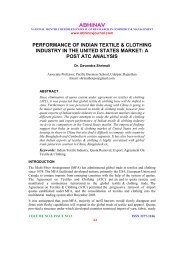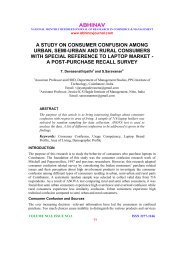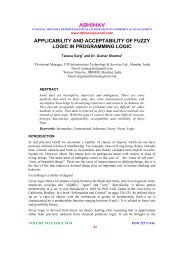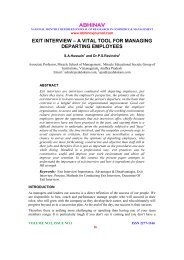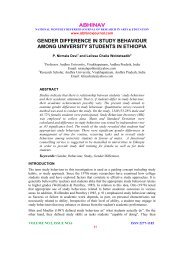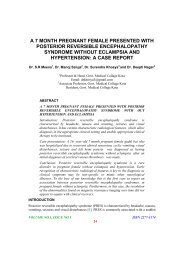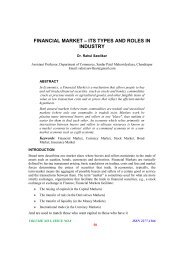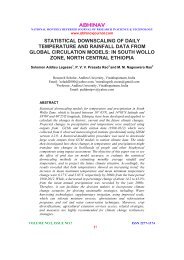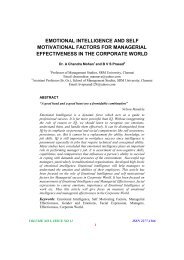Domestic Women Workers in Urban Informal Sector - Abhinav ...
Domestic Women Workers in Urban Informal Sector - Abhinav ...
Domestic Women Workers in Urban Informal Sector - Abhinav ...
Create successful ePaper yourself
Turn your PDF publications into a flip-book with our unique Google optimized e-Paper software.
ABHINAVNATIONAL MONTHLY REFEREED JOURNAL OF REASEARCH IN ARTS & EDUCATIONwww.abh<strong>in</strong>avjournal.comhomes is not given any value or regarded as work. It is also undervalued because it is oftenperformed by poor, migrant women from lower castes. All these contribute to the <strong>in</strong>feriorstates of their work, both <strong>in</strong> their own m<strong>in</strong>ds and <strong>in</strong> society.<strong>Domestic</strong> work, however, is still undervalued. It is looked upon as unskilled because mostwomen have traditionally been considered capable of do<strong>in</strong>g the work, and the skills they aretaught by other women <strong>in</strong> the home are perceived to be <strong>in</strong>nate. When paid, therefore, thework rema<strong>in</strong>s undervalued and poorly regulated. By contrast, studies that provide space fordomestic workers to speak often reveal their belief <strong>in</strong> the dignity of their hard work, and, assuch, it warrants recognition and respect and calls for regulation (D. Roberts 1997).<strong>Domestic</strong> work <strong>in</strong>cludes mental, manual and emotional aspects, <strong>in</strong>clud<strong>in</strong>g care workcommunities (Anderson 2000). <strong>Domestic</strong> work is thus viewed as reproductive work thatcreates not only labour units but also people and social relations. Anderson further drawsattention to domestic work be<strong>in</strong>g rooted <strong>in</strong> the community. By the do<strong>in</strong>g of domestic workwe literally reproduce our communities and our place with <strong>in</strong> them (ibid: 14). In this context,it is important to note who does the domestic work as this reflects the relation betweengenders race and class.The employer-employee relationship is a complex one and is viewed as one of dom<strong>in</strong>ation,dependence and <strong>in</strong>equality. Also, this is an area of work where the employer and theemployee are mostly females. As a home is the site of work, relations between employer andemployee are often not limited to work but spill over as larger support systems.<strong>Domestic</strong> workers <strong>in</strong> India look access to sufficient and effective statutory measures and<strong>in</strong>stitutional mechanisms for their protection. Steps have been taken by the government bothat the national and state levels to protect their rights. Nevertheless, the few labour lawsenacted by the national and state governments address<strong>in</strong>g domestic workers face thechallenge of implementation. This is aggravated by the discrim<strong>in</strong>at<strong>in</strong>g attitude of manyemployers aga<strong>in</strong>st the domestic workers, <strong>in</strong>clud<strong>in</strong>g caste prejudices. As a result those whocarry out domestic work are largely ignored work<strong>in</strong>g sectors often specially excluded andeconomically exploited. On the other hand, the government recognizes the prom<strong>in</strong>ent role ofmigrant domestic workers as a source of foreign exchange <strong>in</strong> the Indian economy and asolution to the country’s unemployment issues. Compared to their local counterparts, ahigher degree of regulation is exerted by the government <strong>in</strong> the process of their deployment.But despite efforts by the government, Indian domestic workers with <strong>in</strong> and outside thecountry rema<strong>in</strong> vulnerable to all forms of exploitation from the moment they enter therecruitment process till they enter the workplace.In its contemporary manifestations, domestic work is a global phenomenon that perpetuateshierarchies based on race, ethnicity, <strong>in</strong>digenous status, caste and nationality, (J. Andall2004). Care work <strong>in</strong> the household – whether performed by paid employees or by unpaidhousehold members as part of their family responsibilities and as a “labour of love” – isquite simply <strong>in</strong>dispensable for the economy outside the household function (D. Roberts1997). The grow<strong>in</strong>g participation of women <strong>in</strong> the labour force, changes <strong>in</strong> the organizationof work and the <strong>in</strong>tensification of work, as well as the lack of policies reconcil<strong>in</strong>g work andfamily life, the decl<strong>in</strong>e <strong>in</strong> state provision of care services, the fem<strong>in</strong>ization of <strong>in</strong>ternationalmigration and the age<strong>in</strong>g of societies have all <strong>in</strong>creased the demand for care work <strong>in</strong> recentyears.VOLUME NO.2, ISSUE NO.2 ISSN 2277-11822
ABHINAVNATIONAL MONTHLY REFEREED JOURNAL OF REASEARCH IN ARTS & EDUCATIONwww.abh<strong>in</strong>avjournal.comeach day and seven days a week. They are also beaten up and <strong>in</strong> some cases, sexuallyabused. Dimensions of traffick<strong>in</strong>g can be seen here as well. Children are often brought <strong>in</strong>from poor areas of the country and made to work as bonded labourers. Many are notallowed to contact their families. They live <strong>in</strong> their employers’ homes without anysupport system.Profile of <strong>Domestic</strong> <strong>Workers</strong><strong>Domestic</strong> workers constitute one of the largest women sectors <strong>in</strong> India. They also representone of the largest numbers of workers <strong>in</strong> the <strong>in</strong>formal economy of the country. The vary<strong>in</strong>gstatistics on their population would illustrate the significance of their participation <strong>in</strong> India’sworkforce. Accord<strong>in</strong>g to Indian National Sample Survey (NSS) data, there were 2.0 millionfemale workers and 0.3 million male workers <strong>in</strong> 2001 as compared to 1.2 million female and0.3 male workers <strong>in</strong> 1983, show<strong>in</strong>g a substantial issues <strong>in</strong> the number of female workers(Mehrotra 2008, 2). It is generally held that the official figures are unreliable and grossly<strong>in</strong>adequate as domestic work is notoriously under enumerated. (Gothoskar 2005, 29;Raghuram 2005, Social Alert (2000, 19) on the basis of <strong>in</strong>formation from several Indian civilsociety organizations, it is estimated that there are around 20 million domestic workers <strong>in</strong>India. Of them about 20% are estimated to be aged fewer than fourteen and 20-25% arefifteen to twenty. While domestic workers <strong>in</strong> most countries are ma<strong>in</strong>ly women and girls, <strong>in</strong>India there are relatively large numbers of male workers. Despite this, domestic work is<strong>in</strong>creas<strong>in</strong>gly fem<strong>in</strong>ized <strong>in</strong> India (Ray 2000b), around 90% of these workers be<strong>in</strong>g female(Social Alert 2000). This makes it one of the few sectors which has a female majority(Raghuram 2005, 5), and one of the largest employment providers for women and girls <strong>in</strong>India. Accord<strong>in</strong>g to the National <strong>Domestic</strong> <strong>Workers</strong>’ Movement [NDWM], an estimated20million people work as domestics throughout the country. Of these workers, 90 percent arewomen and children between the ages of 12 to 75 while those below 14years old make up 25percent of the workers (NDWM).A significant population of women and children domestic workers tends to be concentrated<strong>in</strong> large cities of the country. In Mumbai city alone, an estimated 600,000 domestic workersexist, of whom 80,000 are on full time employment (D. Lakshmi Rani & Mr.Manabendranath Roy, 2005). Banglore is reportedly a host to 500,000 domestic workers.They are ma<strong>in</strong>ly migrant women workers, 25 percent of whom are girls 10-16 years of agewho dropped out of primary school and accompany their mothers to work and would soonend up be<strong>in</strong>g workers <strong>in</strong> their own right (D. Lakshmi Rani & Mr. Manabendranath Roy,2005). Ahmedabad city has more than 50,000 domestic workers constitut<strong>in</strong>g mostly women(SEWA, 2008). On the other hand, 5,000 children mostly girls work as domestic <strong>in</strong> theBhubaneswar, the large city of Orissa, India (Press Trust of India, 2005).VOLUME NO.2, ISSUE NO.2 ISSN 2277-11824
ABHINAVNATIONAL MONTHLY REFEREED JOURNAL OF REASEARCH IN ARTS & EDUCATIONwww.abh<strong>in</strong>avjournal.comTable 1. Statistical estimates of Indian domestic workersDate Organization Place Age <strong>Women</strong> Children TotalRange DW DW below2008 NDWM India 12-75 90% 25% (below 20 Myears14 years)2000 Social Alert India 0 92% 20% (below 20 M14 years)2000 Social Alert Mumbai City 0 0 6000002005 SC-UK Bangalorecity0 They arecomprised ma<strong>in</strong>lyby migrantwomen &25% (10 to16 years)500000Asreported <strong>in</strong>2008Asreported <strong>in</strong>2005SEWAPress Trust ofIndiaAhmedabadcityBhubhaneshwar citychildren0 Constitute mostlywomen workers(did not specifynumber of girlchildren)Source: NDWM, Social Alert, SEWA, Press Trust of India0 500000 0 5000 0Table 1 illustrates the profile of Indian domestic workers by different groups, either allthroughout the nation or <strong>in</strong> a particular city.<strong>Domestic</strong> workers constitute ma<strong>in</strong>ly low caste migrant women workers from neighbor<strong>in</strong>grural areas or from other prov<strong>in</strong>ces or Indian states who would take their children along, towork with them. Majority of these workers have very little or no education. In a socioeconomicsurvey conducted by Self Employed <strong>Women</strong>’s Association, it was found thatalmost half of the 1000 women surveyed were uneducated (SEWA). Table 2 illustrates theeducational atta<strong>in</strong>ment of women domestic workers surveyed.Source: SEWATable 2. Level of education of women domestic workers surveyedSr. No Level of Education Total No. of workers1 Un educated 4212 1to 3 793 4 to 6 1524 7 to 9 2965 10 to 12 876 Graduate 107 Post graduate 0VOLUME NO.2, ISSUE NO.2 ISSN 2277-11825
ABHINAVNATIONAL MONTHLY REFEREED JOURNAL OF REASEARCH IN ARTS & EDUCATIONwww.abh<strong>in</strong>avjournal.com<strong>Domestic</strong> workers, <strong>in</strong> particular women domestic workers, are a constantly grow<strong>in</strong>g sectionof workers <strong>in</strong> the <strong>in</strong>formal sector of urban India. The last three decades have seen a sharp<strong>in</strong>crease <strong>in</strong> their numbers, especially <strong>in</strong> contrast to male domestic workers (Neetha 2004).Research has shown that till 2000, the urban workforce participation of women <strong>in</strong> India hasbeen lower than those of rural women. Marg<strong>in</strong>al <strong>in</strong>creases were observed <strong>in</strong> 2000-04. In2004, the figure of national urban female workforce participation reached an all-time high of16 percent. In 2004-05, there were 30.5 million women domestic workers <strong>in</strong> urban Indiamark<strong>in</strong>g an <strong>in</strong>crease by 22 percent from 1999-2000 (Chandrashekar and Ghoosh 2007)This <strong>in</strong>crease <strong>in</strong> the number of domestic workers is l<strong>in</strong>ked to shift from agrarian – basedeconomy to a manufacture and service based economy. It is also associated with the growthof the urban middle class, especially the <strong>in</strong>crease <strong>in</strong> the number of women work<strong>in</strong>g outsidetheir homes and the availability of cheap domestic labour. The migration from the tribal beltis ascribed to “ecological degradation, landlessness and land alienation, unemployment andpoverty” (Kujar and Jha 2008:25). Migration of girls is also attributed to the transition <strong>in</strong> thetribal societies as educated tribal girls do not want to work <strong>in</strong> the agriculture sector (ibid).Push and pull factors for local domestic workersNDWM identified the follow<strong>in</strong>g socio-economic circumstances (NDWM).Poverty is the ma<strong>in</strong> reason why many women and children engage <strong>in</strong> domestic work.In almost all cases, these domestic workers are the product of <strong>in</strong>ternal migration <strong>in</strong>search of employment.Family problems <strong>in</strong>clud<strong>in</strong>g rural and male unemployment, disputes at home.Ill treatment and loss of parents have resulted <strong>in</strong> their leav<strong>in</strong>g the house to work asdomestics.It is also not unusual to f<strong>in</strong>d domestic workers who are s<strong>in</strong>gle parents, widowed orseparated from their husbands or those with alcoholic husbands who are compelledto work for the survival of their children.Natural calamities and conflict situation such as <strong>in</strong>surgency are also factors forc<strong>in</strong>gthem to migrate because of displacement and loss of livelihood and the lack ofrehabilitation programmes.As well, their debts due to fall<strong>in</strong>g crops also drive them to domestic work.On the other hand the demand of cheap labor <strong>in</strong> the grow<strong>in</strong>g market economies hascaused many women and children to seek employment <strong>in</strong> the cities and urban areas.The urbanization, the break-up of traditional jo<strong>in</strong>t family system, and the <strong>in</strong>creaseddemand for domestic workers from middle-class women who are tak<strong>in</strong>g up jobsoutside the home also contribute to more poor women and girls migrat<strong>in</strong>g from ruralvillages to cities and urban areas <strong>in</strong> search of domestic work (CWA News Letter,2004).The glamour of city life and the rais<strong>in</strong>g consumerism also lure them to domesticwork.VOLUME NO.2, ISSUE NO.2 ISSN 2277-11826
ABHINAVNATIONAL MONTHLY REFEREED JOURNAL OF REASEARCH IN ARTS & EDUCATIONwww.abh<strong>in</strong>avjournal.comThe lack of access to education, especially among young girls, and false image ofsecurity and a stable, environment at the employer’s home are factors that enticethem to domestic work.The <strong>in</strong>creas<strong>in</strong>g development and urbanization of certa<strong>in</strong> <strong>in</strong>dustries <strong>in</strong> India have alsoled to unemployment of workers <strong>in</strong> certa<strong>in</strong> sectors.For <strong>in</strong>stance, the adverse repercussions of mechanizations of agriculture led to lossof livelihood by agriculture workers. As a result, women and children migrate forwork as domestic to address the economic problems of their family.Children end up <strong>in</strong> domestic work <strong>in</strong> other areas through different recruitmentpatterns that facilitate their migration. Children from rural areas com<strong>in</strong>g from poorfamilies are sent to live with better off relatives <strong>in</strong> urban areas with promise that theywill be treated by relatives as their own children; some are sent together with otherhousehold goods for purposes of child marriage; most have ran away from home andended up as domestics <strong>in</strong> urban areas; and they are recruited from their villages bymiddle men and women (CWA News Letter, 2004).The practice of child debt bondage to domestic labor <strong>in</strong> India is also a cause formigration of the child to live and work <strong>in</strong> the employer’s home usually <strong>in</strong> urbanareas to pay the debts of the child’s family.A significant number of children are believed to be <strong>in</strong> bondage domestic work. Thisis a common practice <strong>in</strong> India although no studies are available to determ<strong>in</strong>e thenumber of children <strong>in</strong> bondage of domestic work. The effect of enforcement of childlabor law may have established a pattern of driv<strong>in</strong>g bonded child laborers’ fromfactories <strong>in</strong>to households and other home-based production units that are less likelyto be visible to regulation (William F. Stafford, 2007).Wages and Work<strong>in</strong>g Conditions<strong>Domestic</strong> work <strong>in</strong>cludes perform<strong>in</strong>g the tasks such as house clean<strong>in</strong>g, laundry, cook<strong>in</strong>g, dishwash<strong>in</strong>g, care of children and the aged, and various other activities associated with theregular and smooth function<strong>in</strong>g of a household.Many studies have reported that there are no standard norms that decide work<strong>in</strong>g conditionsfor domestic workers. Specified work<strong>in</strong>g hours does not exist for many domestic workers.They can work from 8 to 18 hours a day while live <strong>in</strong> domestic workers are on call 24 hourseach day (Kalpana Sarma 2003). Some dome not gets any rest dur<strong>in</strong>g the day while othersmay not be given proper food or liv<strong>in</strong>g space. Child domestic workers <strong>in</strong> particular are foundto have unspecified hours of work, usually an average of 15 hours each day seven days aweek and are on call day and night (SC-UK Supra Note 5) Because they have no fixed hoursof work they sleep as late as 2 or 3 am and wake up at 5:30 a.m. Live out domestic workersalso suffer long work<strong>in</strong>g hours <strong>in</strong> differ<strong>in</strong>g households each day from early morn<strong>in</strong>g until theeven<strong>in</strong>g. (SEWA)<strong>Domestic</strong> workers are among the lowest paid workers <strong>in</strong> India and are paid an amount whichis even below the m<strong>in</strong>imum wage of semi-skilled and unskilled workers (NDWM). In 2008,the wages of women domestic workers were less than the national floor level m<strong>in</strong>imum wageVOLUME NO.2, ISSUE NO.2 ISSN 2277-11827
ABHINAVNATIONAL MONTHLY REFEREED JOURNAL OF REASEARCH IN ARTS & EDUCATIONwww.abh<strong>in</strong>avjournal.comof 80 rupees per day, both <strong>in</strong> rural and urban areas. (M<strong>in</strong>istry of labour and employment).Wage rates also vary by region and type of work, although some of this variation may be aresult of the relatively small numbers surveyed. Cook<strong>in</strong>g is the best paid occupation, but <strong>in</strong>all categories female wages are lower than male wages, as is the case <strong>in</strong> other occupations. Itis strik<strong>in</strong>g that while qualitative f<strong>in</strong>d<strong>in</strong>g <strong>in</strong>dicate that girls/ women are preferred as childm<strong>in</strong>ders and governesses, male wages are higher even <strong>in</strong> this category.The wages of urban, part time workers are first of all differentiated by the board division ofwork, such as cook<strong>in</strong>g, clean<strong>in</strong>g, and babysitt<strong>in</strong>g, clean<strong>in</strong>g tasks, which are paid between100-400 rupees per month (<strong>in</strong> 2008): the work also <strong>in</strong>cludes dust<strong>in</strong>g, sweep<strong>in</strong>g and mopp<strong>in</strong>g,laundry and dishwash<strong>in</strong>g, (Palriwala and Neetha). The wage is tied to the hours that are spentat this task daily, which vary with frequency of visits <strong>in</strong> a day, the size of the house, and thenumber of house hold members. However, s<strong>in</strong>ce equivalence is difficult, part-time workersmay avoid work<strong>in</strong>g for large households. The same or different workers may undertake eachof the clean<strong>in</strong>g tasks, such as cook<strong>in</strong>g, childcare and elder care. The returns per hour of workdecl<strong>in</strong>e as one moves from cook<strong>in</strong>g to elder care and then to child care, reflect<strong>in</strong>g social andcultural notions of skill, purity and labour <strong>in</strong>tensity.The wages of live-<strong>in</strong> workers range between 1000 to 4000 rupees per month (<strong>in</strong> 2008),depend<strong>in</strong>g on the worker’s experience and the specific tasks to which they are assigned.Board, lodg<strong>in</strong>g, clothes, and other articles of daily use are provided. In look<strong>in</strong>g at the returnsto their labour, however, a number of features have to be noted. Despite the specification oftheir work, the workers often must undertake multiple tasks, though the <strong>in</strong>tensity of their<strong>in</strong>volvement may vary. They are on call twenty-four hours a day. The basic wage perks, andbenefits, such as festival bonus, loans, medical costs, and gifts at life cycle rituals, all differas a result of the length of service of the worker and the personal ties that have formedbetween them and their employers, which is likely to be closer among live-<strong>in</strong>, rather thanpart-time workers.The fragmentation of the domestic labour market by the area of residence and the class of theemployer with<strong>in</strong> one town/city is noticeable. The same broad tasks are elaborated and oftenperformed differently under varied conditions of service. Segmented and niche markets havedeveloped. Thus, for example, the rates paid by expatriates are among the highest. Ethnicstereotypes regard<strong>in</strong>g skill and efficiency also affect the wages and treatment of domesticworkers (Surabhi Tandon Mehrotra, 2008). In sum, the wage structure and service packagesare complex and variable, mak<strong>in</strong>g it problematic to arrive at a uniform wage rate fordomestic work even for a specific locality (Palriwala and Neetha). This br<strong>in</strong>gs difficulty <strong>in</strong>unionization and legislation and is used as an argument to justify the lack of regulation.Legislation on Protection of <strong>Domestic</strong> <strong>Workers</strong><strong>Domestic</strong> workers are excluded from labour welfare laws. Early judgments do not considerthem as ‘workmen ‘under the Trade Unions Act of 1926 those engaged <strong>in</strong> personal service,(WIEGO). Most other labour laws <strong>in</strong> the country hold the same position that they are notapplicable because the household and the home are perceived as a non ‘<strong>in</strong>dustry’ entity(Reference of Supreme Court Decision 1978). As such domestic workers are currently notwith<strong>in</strong> the scope of most labour laws. They cannot demand rights for their decent work<strong>in</strong>gconditions, m<strong>in</strong>imum wages, social security, hours of work, weekly offs paid leaves ormedical benefits among others.VOLUME NO.2, ISSUE NO.2 ISSN 2277-11828
ABHINAVNATIONAL MONTHLY REFEREED JOURNAL OF REASEARCH IN ARTS & EDUCATIONwww.abh<strong>in</strong>avjournal.comNone of the Act meant for promotion of workers nights <strong>in</strong>cluded domestic workers <strong>in</strong> itscoverage. Attempts to br<strong>in</strong>g <strong>in</strong> a national legislation for domestic worker regulation havebeen made over the years but have yet to meet its success (Reference of Supreme CourtDecision 1978. Several states have also made efforts to enact their own labour legislation ondomestic workers with some success <strong>in</strong> other states (Reference of Supreme Court Decision1978).The states which had some efforts are Andhra Pradesh, Bihar, Kerala, Maharashtra,Rajasthan and Tamil Nadu, Laws to enable domestic workers to avail of social securityprovisions have been amended or passed <strong>in</strong> Kerala (Kerala Artisan and Skilled <strong>Workers</strong>’Welfare Fund), Maharashtra (Maharashtra <strong>Domestic</strong> <strong>Workers</strong> Welfare Board Act, 2008), andTamil Nadu: (Manual <strong>Workers</strong> Act (Regulation and Employment and Conditions of Work),1982). However, the gaps between the existence of a law or welfare program, knowledge ofit among potential beneficiaries, and the actual operation and coverage have to be noted.The employment of children <strong>in</strong> domestic work was not legally prohibited, but <strong>in</strong> 2006 thegovernment of India imposed an amendment to the exist<strong>in</strong>g Child Labour Act (1986). Theamendment prohibits the employment of children under fourteen as a domestic servants or <strong>in</strong>roadside cafeterias, tea shops, hotels and other hospitality sectors (Save the Children2007,2). For Child Rights Organization, the enactment of the 2006 amendment was majorachievement. Although they rema<strong>in</strong> skeptical about the implementation of the ban, theyexpressed legitimate concerns over the lack of implementation of the amendment, given theGovernment marg<strong>in</strong>al efforts <strong>in</strong> putt<strong>in</strong>g it <strong>in</strong>to practice.After much lobby<strong>in</strong>g, domestic workers were brought with<strong>in</strong> the ambit of the recent 2008Unorganized <strong>Workers</strong> Social Security Act. Although the rules under this act have still to beframed, the fact is that this law does not provide for any enforceable or justiciable socialsecurity entitlement for unorganized workers. The only legal entitlement <strong>in</strong> the entire act isthe right of all unorganized sector workers above fourteen years of age to register themselvesand receive a “smart” identity card. It has been argued by many that the name of the act itselfis a misnomer because it does not guarantee anyth<strong>in</strong>g other than the formation of advisoryboards at the central and state levels. There are no provisions for penaliz<strong>in</strong>g employers orbureaucrats who violate the provisions of the act. It is a statement of pious hope, rather than<strong>in</strong>tent, which is <strong>in</strong> keep<strong>in</strong>g with the foot-dragg<strong>in</strong>g of earlier governments.The National Commission for <strong>Women</strong> has attempted to address some of the concernsthrough the 2008 <strong>Domestic</strong> <strong>Workers</strong> (Registration, Social Security and Welfare) Bill, and ithas held a few consultations. The proposal <strong>in</strong>cludes a compulsory registration procedure forall domestic workers, both part-time and full-time, a welfare fund to which workers andemployers will contribute, the registration of service providers (placement agencies), theregulation of work<strong>in</strong>g conditions, and f<strong>in</strong>es and imprisonment for the violation of theprovisions of the bill. Interest<strong>in</strong>gly, it grants powers of <strong>in</strong>spection to any registered tradeunion. A similar proposal has also been drafted by the National Campaign Committee forUnorganized <strong>Workers</strong> and Nirmala Niketan, which is entitled the 2008 <strong>Domestic</strong> <strong>Workers</strong>(Regulation of Employment, Conditions of Work, Social Security and Welfare) Bill. Thedebates and discussion around these bills <strong>in</strong>clude the def<strong>in</strong>ition of a domestic worker, anemployer, and wages, the mode of delivery of welfare benefits, and the criteria fordeterm<strong>in</strong><strong>in</strong>g m<strong>in</strong>imum wages, which neither bill expressly addresses. While many of theVOLUME NO.2, ISSUE NO.2 ISSN 2277-11829
ABHINAVNATIONAL MONTHLY REFEREED JOURNAL OF REASEARCH IN ARTS & EDUCATIONwww.abh<strong>in</strong>avjournal.comspecificities of domestic work are factored <strong>in</strong>, issues of implementation, which must beexam<strong>in</strong>ed <strong>in</strong> relation to other <strong>in</strong>formal workers, have not been worked through.Discussions abound, but progress <strong>in</strong> enact<strong>in</strong>g or amend<strong>in</strong>g legislation is slow, reiterat<strong>in</strong>g theapathy of the state <strong>in</strong> provid<strong>in</strong>g legal protection to domestic workers. Added to theparticulars of domestic work and employment, the reluctance to accept the home as a workplace is the low priority attached to labour rights and welfare <strong>in</strong> the current policy paradigm.Issues of Social Security and WelfareIn India, <strong>Domestic</strong> workers lack healthcare and social security. Their medical benefits areabsent and totally depend on their employers. For <strong>in</strong>stance; SEWA survey showed that liveoutdomestic workers do not have social security. Many domestic workers suffer form healthhazards brought by their work<strong>in</strong>g conditions. For <strong>in</strong>stance, SEWA reported that nearly 934women live-out domestic workers were suffer<strong>in</strong>g from back pa<strong>in</strong> but are not gett<strong>in</strong>g anymedical help from their employer. Some health issues compla<strong>in</strong>ed by the surveyed 1000domestic workers <strong>in</strong>clude pa<strong>in</strong> <strong>in</strong> the sp<strong>in</strong>al cord, <strong>in</strong>jury and sk<strong>in</strong> allergies that they tend toneglect (SEWA). Medical <strong>in</strong>surance cover<strong>in</strong>g work related sicknesses are normally absent.Some of these women work as domestic workers over long time periods but have little or nosav<strong>in</strong>gs for their old age.Organiz<strong>in</strong>g <strong>Domestic</strong> <strong>Workers</strong>Indian domestic workers are often scattered, unorganized and unaware of their rights. It hasbeen reported that the M<strong>in</strong>istry of Labour <strong>in</strong> 2001-2002 cited certa<strong>in</strong> problems specific tounorganized workers <strong>in</strong>clud<strong>in</strong>g the domestic workers (Rasika Dhavse 2004) Accord<strong>in</strong>gly themajor impediment for a decent work<strong>in</strong>g conditions for unorganized sectors <strong>in</strong>clud<strong>in</strong>gdomestic workers are: the absence of ‘formal employee-employer relationship, lack oforganization, poor barga<strong>in</strong><strong>in</strong>g power, low legislative protection, and <strong>in</strong>adequate welfaremeasures’ (IBID). S<strong>in</strong>ce the overwhelm<strong>in</strong>g majority of workers <strong>in</strong> India are <strong>in</strong> the <strong>in</strong>formalsector, it is not surpris<strong>in</strong>g that most domestic workers are not unionized or otherwiseorganized. The needs of the <strong>in</strong>formal sector workers, women workers are <strong>in</strong> particular havebeen overlooked by the conservative practice of labour organization and the trade unions(Baruah 2004)Participation <strong>in</strong> union activities is difficult due to the hours and nature of domestic workers’work and their social and political vulnerabilities as well as because of the familialresponsibilities for part-time workers and the isolation of live-<strong>in</strong> workers. Only a smallfraction of domestic workers <strong>in</strong> the country are <strong>in</strong> touch with associations or are unionized.The lack of unionization is a critical factor <strong>in</strong> their exclusion from labour laws, the violationof national, legal norms <strong>in</strong> their wage fixation, and the absence of entitlements to varioussocial security benefits. However, although the beg<strong>in</strong>n<strong>in</strong>gs of success as a pressure group arefairly new, associations of domestic workers <strong>in</strong> India have a long and mixed history. One ofthe earliest collective actions of domestic workers was a twenty-six- day hunger strike calledby the New Delhi-based All India <strong>Domestic</strong> <strong>Workers</strong>’ Union <strong>in</strong> 1959, which receivedsupport <strong>in</strong> a few urban centres. A call for a one-day solidarity strike led to the <strong>in</strong>troduction ofthe two private members’ bills <strong>in</strong> Parliament.The National <strong>Domestic</strong> <strong>Workers</strong> Movement has campaigned for the rights of domesticworkers <strong>in</strong> many states and claims to have reached over two million domestic workers acrossVOLUME NO.2, ISSUE NO.2 ISSN 2277-118210
ABHINAVNATIONAL MONTHLY REFEREED JOURNAL OF REASEARCH IN ARTS & EDUCATIONwww.abh<strong>in</strong>avjournal.comthe country. Thus; the NDWM has played a role along with other organizations <strong>in</strong> br<strong>in</strong>g<strong>in</strong>g<strong>in</strong> m<strong>in</strong>imum wage legislation <strong>in</strong> Karnataka and a state welfare board bill for domesticworkers <strong>in</strong> Maharashtra.Other organizations, such as the All India Democratic <strong>Women</strong>’s Association (AIDWA), havetaken up specific issues or have organized workers with small successes with<strong>in</strong> a limited area(SEWA). Issues <strong>in</strong>clude the amount and the non-payment of wages, recognition as workers,sexual harassment, physical violence, forced attachment of children, compensation for workrelated<strong>in</strong>juries, legal aid, and the formation of self-help groups (Jagori).The Self-Employed <strong>Women</strong>’s Association (SEWA) is a trade union organization of “poor,self-employed women workers.” SEWA seeks to organize women workers <strong>in</strong> India for fullemployment where they can atta<strong>in</strong> security on their work, <strong>in</strong>come, food as well as socialsecurity, which at the m<strong>in</strong>imum would <strong>in</strong>clude health care, childcare and shelter.SEWA has actively campaigned to organize domestic workers to give them voice, visibilityand representation. S<strong>in</strong>ce domestic workers are scattered, unorganized and cannot all bereadily found <strong>in</strong> one employment area, SEWA would do door to door campaign andpersonally talk to domestic workers. These workers are then encouraged to become membersof the organization and become <strong>in</strong>volved <strong>in</strong> its activities. SEWA’s programmes and activitiesrelated to domestic workers <strong>in</strong>clude provid<strong>in</strong>g workers’ education for domestic workers,form<strong>in</strong>g a trade committee of domestic workers, undertake collective barga<strong>in</strong><strong>in</strong>g asrepresentative of domestic workers when negotiat<strong>in</strong>g with their employers, conduct<strong>in</strong>gdatabase study <strong>in</strong>volv<strong>in</strong>g domestic workers, lobby<strong>in</strong>g to the legislators for the enactment ofm<strong>in</strong>imum wage and lobby<strong>in</strong>g to the Labour and Employment Department for the <strong>in</strong>clusion ofdomestic workers <strong>in</strong> the government agency’s welfare board.The National Commission for <strong>Women</strong> (NCW) is a national level organization mandated bylaw to protect and promote women’s rights and <strong>in</strong>terests (NCW 1992). NCW has played animportant role <strong>in</strong> the lobby of various groups for the draft<strong>in</strong>g of national domestic workerslegislation. It has proposed the <strong>Domestic</strong> <strong>Workers</strong> (Registration Social Security and Welfare)Act, 2008 that will establish the Comprehensive Central Legislation for the purpose ofregister<strong>in</strong>g and meet<strong>in</strong>g the work<strong>in</strong>g conditions of domestic workers (WIEGO). The draftlaw envisaged among others the mandatory registration of domestic workers, and the sett<strong>in</strong>gof welfare fund to provide for the social security of workers (Sujatha Madhok 2008). Thedraft law also recommended the non-employment of children below 18 years old (ibid).India has one of the most vibrant experiences <strong>in</strong> terms of organiz<strong>in</strong>g and advocacy fordomestic workers. This is evident <strong>in</strong> the numerous domestic workers organizations andsupport groups <strong>in</strong> the country. Advocacies for domestic worker legislation and policy reformtowards domestic worker protection exceeds many countries <strong>in</strong> the region <strong>in</strong> theiraccomplishments, however there are hundreds of thousands of domestic workers to yet to bereached and many other laws to enact to ensure their safety, decent work and security.CONCLUSION<strong>Domestic</strong> workers <strong>in</strong> India belong to a greatly disadvantaged work<strong>in</strong>g sector <strong>in</strong> the country.They are part of the <strong>in</strong>formal economy with very m<strong>in</strong>imal if not absent regulation by thegovernment and have <strong>in</strong> most cases no protection <strong>in</strong> law. Mostly composed of women andchildren, they hardly figure <strong>in</strong> the statistical records and the laws of country and rema<strong>in</strong>edVOLUME NO.2, ISSUE NO.2 ISSN 2277-118211
ABHINAVNATIONAL MONTHLY REFEREED JOURNAL OF REASEARCH IN ARTS & EDUCATIONwww.abh<strong>in</strong>avjournal.com<strong>in</strong>visible workers. They usually come from lower caste, with very little education and areoften unaware of their rights.With<strong>in</strong> India, many women and children domestic workers are vulnerable or cont<strong>in</strong>ue tosuffer other k<strong>in</strong>ds of abuses <strong>in</strong> violation of their human rights. Inside the home of theiremployers, where there are no checks and controls <strong>in</strong> place they do not have protectionaga<strong>in</strong>st employers or other members of the family who exploit and sexually, physically andpsychologically abuse them.Activists and researchers have regularly po<strong>in</strong>ted out that women workers face discrim<strong>in</strong>ation<strong>in</strong> the form non-recognition as workers, <strong>in</strong>equality of wages and denial of rights, especially<strong>in</strong> the unorganized sector.The constantly chang<strong>in</strong>g urban scenario, with evictions and displacement, has affected theirlife, livelihood and, <strong>in</strong> turn, their dignity. The challenge, then, is to <strong>in</strong>volve workers, unionsand workers organizations, employers and the state <strong>in</strong> this debate to identify steps to addressthe issues.<strong>Domestic</strong> work is not recognized as ‘work’ by the Indian government. The state does notvalue or recognize this work as a contribution to society and the economy. Trade unions andother organizations work<strong>in</strong>g with domestic workers have been pressuriz<strong>in</strong>g the state for ashift <strong>in</strong> its policy on domestic work. As <strong>in</strong> the case of anganwadi workers, limitedrecognition means that the economic value of non-familial care cont<strong>in</strong>ues to be devalued.This is compounded by the fact that a workforce of women is constantly available to meetthe rapidly grow<strong>in</strong>g demand. Poverty, lack of options and lack of <strong>in</strong>formation aboutorganiz<strong>in</strong>g forces these women to accept the work<strong>in</strong>g conditions.The process of mobiliz<strong>in</strong>g domestic workers is complex and long term. To beg<strong>in</strong> with, thiswould <strong>in</strong>volve empower<strong>in</strong>g domestic workers. This is possible only when the right to formcollectives is granted. The understand<strong>in</strong>g of collective barga<strong>in</strong><strong>in</strong>g power can br<strong>in</strong>g aboutthis change as there has to be a sense of solidarity among them to challenge ill treatmentor unfair wages.The collectives <strong>in</strong> the form of unions or organizations will, <strong>in</strong> turn, work towards demand<strong>in</strong>gand implement<strong>in</strong>g legislations. The onus thus lies on the state to protect domestic workers bylaw and enable them to jo<strong>in</strong> and form associations and unions. These rights must bepublicized and supported by the state by ensur<strong>in</strong>g that employers are aware of their workers’rights.In conclusion, one can assert that rules and laws that recognize domestic workers as workers<strong>in</strong> the home, and that regulate their work<strong>in</strong>g conditions and pay, as well as the agents whomediate the worker-employer relationship, could have a fundamental impact on theconditions of work across the <strong>in</strong>formal sector and the nature of social policy <strong>in</strong> India as wellas on the valuation of women’s work and the gendered divisions <strong>in</strong> work, marriage, and thefamily.REFERENCES1. J. Andall: Gender, migration and domestic service (Aldershot, Ashgate, 2000); ILO: Arapid assessment of bonded labour <strong>in</strong> domestic work and begg<strong>in</strong>g <strong>in</strong> Pakistan, Work<strong>in</strong>gPaper, Collective for Social Science Research, Karachi (Geneva, Mar. 2004).VOLUME NO.2, ISSUE NO.2 ISSN 2277-118212
ABHINAVNATIONAL MONTHLY REFEREED JOURNAL OF REASEARCH IN ARTS & EDUCATIONwww.abh<strong>in</strong>avjournal.com2. D.E. Roberts: “ Spiritual and menial housework”, <strong>in</strong> aYale Journal of Law and Fem<strong>in</strong>ism(1997), Vol. 9, No. 51.3. Anderson, Bridget. 2000. Do<strong>in</strong>g the Dirty Work? The Global Politics of <strong>Domestic</strong>Labour London, Newyouk: Zed Books.4. IBID5. Ray, Raka and Qayum, Seem<strong>in</strong> (2009). Cultures of Servitude. Modernity,<strong>Domestic</strong>ity, and Class <strong>in</strong> India. Stanford: Stanford University Press.6. ILO7. J. Rodgers: “Cambios en el servicio domestic en America Lat<strong>in</strong>a”, <strong>in</strong> N:E: Valenzuela(ed.): Trabajadores domesticas: <strong>in</strong> largo cam<strong>in</strong>o hacia el trabajo devente (Santiago, ILO,2008), p. 20; and M. Diaz Gorf<strong>in</strong>kiel: The situration of migrant and non-migrantdomestic labour <strong>in</strong> Lat<strong>in</strong> America and ILO’s work <strong>in</strong> the region ILO,2008)8. M. Jacquem<strong>in</strong>: “Travail domestique et travail des enfants, le cas d’Abidjan (Coted’Ivoire)”, <strong>in</strong> Revue Tiers Monde (Paris, Armand Col<strong>in</strong>, 2002), Apr-June, pp. 307-326.9. Kaur, Rav<strong>in</strong>der, 2006, ‘ Migrat<strong>in</strong>g For Work: Rewrit<strong>in</strong>g Gender Relations’ InSadhna Arya & Anupama Roy (eds.) Poverty Gender and Migration: <strong>Women</strong>migration <strong>in</strong> Asia, Sage Publications, New Delhi.10. UNICEF 2007 www.unicef.org/<strong>in</strong>dia/child_protection_2053.htm11. Mehrotra, Surabhi Tandon (2008). Rights and Dignity: <strong>Women</strong> <strong>Domestic</strong> <strong>Workers</strong> <strong>in</strong>Jaipur. Research and fact f<strong>in</strong>d<strong>in</strong>g by Mewa Bharati, New Delhi: Jagori.12. Gothoskar, Sujata (2005). New <strong>in</strong>itiatives <strong>in</strong> organiz<strong>in</strong>g strategy <strong>in</strong> the <strong>in</strong>formal econom– Case study of domestic workers’ organiz<strong>in</strong>g. Bangkok: Committee for Asian <strong>Women</strong>July 2005.13. Raghuram, Parvati (2005). Global maid trade: Indian domestic workers <strong>in</strong> the globalmarket, <strong>in</strong> Shirlena Huang, Noorashik<strong>in</strong> Abdul Rahman and Brenda Yeoh (eds.). AsianTransnational <strong>Domestic</strong> <strong>Workers</strong>, S<strong>in</strong>gapore: Marshall Cavendish. 1–32. A draft version.14. Social Alert (2000). Invisible Servitude. An In-Depth Study on <strong>Domestic</strong> <strong>Workers</strong> of theWorld. Description and Recommendations for Global Action. Brussels: Research onHuman Rights.15. Ray, Raka (2000b). Mascul<strong>in</strong>ity, fem<strong>in</strong><strong>in</strong>ity, and servitude: domestic workers <strong>in</strong> Calcutta<strong>in</strong> the late twentieth century. Fem<strong>in</strong>ist Studies 26, no. 3, 691–718.16. Social Alert (2000). Invisible Servitude. An In-Depth Study on <strong>Domestic</strong> <strong>Workers</strong> of theWorld. Description and Recommendations for Global Action. Brussels: Research onHuman Rights.17. Raghuram, Parvati (2005). Global maid trade: Indian domestic workers <strong>in</strong> the globalmarket, <strong>in</strong> Shirlena Huang, Noorashik<strong>in</strong> Abdul Rahman and Brenda Yeoh (eds.). AsianTransnational <strong>Domestic</strong> <strong>Workers</strong>, S<strong>in</strong>gapore: Marshall Cavendish. 1–32. A draft version.18. National <strong>Domestic</strong> <strong>Workers</strong> Movement http://www.ndwm.org/VOLUME NO.2, ISSUE NO.2 ISSN 2277-118213
ABHINAVNATIONAL MONTHLY REFEREED JOURNAL OF REASEARCH IN ARTS & EDUCATIONwww.abh<strong>in</strong>avjournal.com19. Social alert 2000 estimates cited <strong>in</strong> Child domestic work: a violation of human rights,Report on the legal position of child <strong>Domestic</strong> workers <strong>in</strong> India, Dr.D. Lakshmi Rani andMr. Manabendranath Roy (eds.) 2005.20. IBID21. Issues faced by domestic workers: Organiz<strong>in</strong>g strategies used by SEWA-Self Employed<strong>Women</strong>’s Association, A Paper Presentation on the Regional conference on <strong>Domestic</strong><strong>Workers</strong> Asian <strong>Domestic</strong> <strong>Workers</strong> Network and Committee of Asian <strong>Women</strong> on 26-27 thAugust 2008 Bangkok. (Issues faced by domestic workers: SEWA)22. Press Trust of India, Save toil<strong>in</strong>g tykes, unionize domestic help, 2 nd May 2005http://www.express<strong>in</strong>dia.com/news/fullstory.php?newsid=45958#compstory23. Issues faced by domestic worker: SEWA. Supra note724. Neetha, N. 2004. ‘Mak<strong>in</strong>g of Female Breadw<strong>in</strong>ners. Migration and SocialNetwork<strong>in</strong>g of <strong>Women</strong> domestic <strong>in</strong> Delhi’ Economic and Political Weekly April24, 2004, pp. 1681 – 8825. Chandrashekhar C.P, and Jayuanthi Ghosh, 2007. ‘<strong>Women</strong> <strong>Workers</strong> <strong>in</strong> <strong>Urban</strong>India. Macrocan, Feb, 6,2007 http://www.macroscan.com/fet/feb07/fet060207<strong>Women</strong>_<strong>Workers</strong>.htm26. Kujur, Joseph Marianus and vikas Jah, 2008. Tribal <strong>Women</strong> <strong>Domestic</strong> <strong>Workers</strong> <strong>in</strong>Delhi. DilhiL ISI27. IBID28. See National <strong>Domestic</strong> <strong>Workers</strong>’ Movement http://www.ndwm.org/about-dw/default/asp29. Child <strong>Workers</strong> <strong>in</strong> Asia CWA Newsletter Volume 20, Numbers ½, January-April 200430. IBID31. Understand<strong>in</strong>g Bonded Child Labour <strong>in</strong> Asia, An Introduction to the nature of theproblem and how to address it, Child <strong>Workers</strong> <strong>in</strong> Asia (CWA) Task Force on BondedChild Labour, William F. Stafford, Jr. (Primary Auth and Ed.) (2007) (Here<strong>in</strong> afterStafford CWA, Understand<strong>in</strong>g Child Labour <strong>in</strong> Asia)32. One World South Asia, ‘<strong>Domestic</strong> workers <strong>in</strong> India no better than slaves’, kalpanaSharma 17 February 2009.33. http://southasia.oneworld.net/op<strong>in</strong>ioncomment/domestic-workers-<strong>in</strong>-<strong>in</strong>dia-no-betterthan-slaves34. SC-UK, supra note 535. Issues faced by domestic worker: SEWA, supra note 736. National <strong>Domestic</strong> <strong>Workers</strong> Movement http://www.ndwm.org/about-dw/migrant-dw.asp37. Indian Together, Rasika Dhavse April 2004, Organis<strong>in</strong>g <strong>in</strong>side the home,http://www.<strong>in</strong>diatogether.org/2004/apr/eco-domestic.htm cit<strong>in</strong>g the Annual Report 2001-2002 of M<strong>in</strong>istry of LabourVOLUME NO.2, ISSUE NO.2 ISSN 2277-118214





